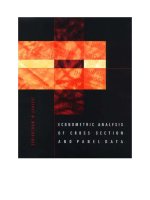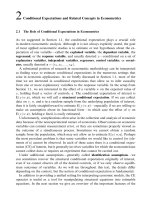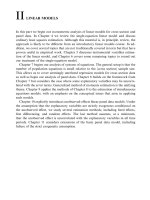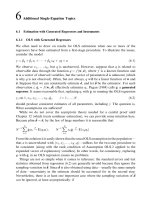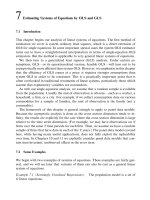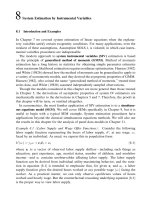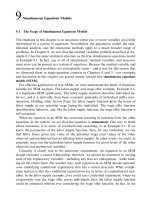Book Econometric Analysis of Cross Section and Panel Data By Wooldridge - Overview pps
Bạn đang xem bản rút gọn của tài liệu. Xem và tải ngay bản đầy đủ của tài liệu tại đây (107.38 KB, 20 trang )
Econometric Analysis of Cross Section and Panel Data
Je¤rey M. Wooldridge
The MIT Press
Cambridge, Massachusetts
London, England
Contents
Preface xvii
Acknowledgments xxiii
I INTRODUCTION AND BACKGROUND 1
1 Introduction 3
1.1 Causal Relationships and Ceteris Paribus Analysis 3
1.2 The Stochastic Setting and Asymptotic Analysis 4
1.2.1 Data Structures 4
1.2.2 Asymptotic Analysis 7
1.3 Some Examples 7
1.4 Why Not Fixed Explanatory Variables? 9
2 Conditional Expectations and Related Concepts in Econometrics 13
2.1 The Role of Conditional Expectations in Econometrics 13
2.2 Features of Conditional Expectations 14
2.2.1 Definition and Examples 14
2.2.2 Partial E¤ects, Elasticities, and Semielasti cities 15
2.2.3 The Error Form of Models of Conditional Expectations 18
2.2.4 Some Properties of Conditional Expectations 19
2.2.5 Average Partial E¤ects 22
2.3 Linear Projections 24
Problems 27
Appendix 2A 29
2.A.1 Properties of Conditional Expectations 29
2.A.2 Properties of Conditional Variances 31
2.A.3 Properties of Linear Proje ctions 32
3 Basic Asymptotic Theory 35
3.1 Convergence of Deterministic Sequences 35
3.2 Convergence in Probability and Bounded in Probability 36
3.3 Convergence in Distribution 38
3.4 Limit Theorems for Rand om Samples 39
3.5 Limiting Behavior of Estimators and Test Statistics 40
3.5.1 Asymptotic Properties of Estimators 40
3.5.2 Asymptotic Properties of Test Statistics 43
Problems 45
II LINEAR MODELS 47
4 The Single-Equation Linear Model and OLS Estimation 49
4.1 Overview of the Single-Equation Linear Model 49
4.2 Asymptotic Properties of OLS 51
4.2.1 Consistency 52
4.2.2 Asymptotic Inference Using OLS 54
4.2.3 Heteroskedasticity-Robust Inference 55
4.2.4 Lagrange Multiplier (Score) Tests 58
4.3 OLS Solutions to the Omitted Variables Problem 61
4.3.1 OLS Ignoring the Omitted Variables 61
4.3.2 The Proxy Variable–OLS Solution 63
4.3.3 Models with Interactions in Unobservables 67
4.4 Properties of OLS under Measurement Error 70
4.4.1 Measurement Error in the Dependent Variable 71
4.4.2 Measurement Error in an Explanatory Variable 73
Problems 76
5 Instrumental Variables Estimation of Single-Equation Linear Models 83
5.1 Instrumental Variables and Two-Stage Least Squares 83
5.1.1 Motivation for Instrumental Variables Estimation 83
5.1.2 Multiple Instruments: Two-Stage Least Squares 90
5.2 General Treatment of 2SLS 92
5.2.1 Consistency 92
5.2.2 Asymptotic Normality of 2SLS 94
5.2.3 Asymptotic E‰ciency of 2SLS 96
5.2.4 Hypothesis Testing with 2SLS 97
5.2.5 Heteroskedasticity-Robust Inference for 2SLS 100
5.2.6 Potential Pitfalls with 2SLS 101
5.3 IV Solutions to the Omitted Variables and Measurement Error
Problems 105
5.3.1 Leaving the Omitted Factors in the Error Term 105
5.3.2 Solutions Using Indicators of the Unobservables 105
Problems 107
6 Additional Single-Equation Topics 115
6.1 Estimation with Generated Regressors and Instruments 115
Contentsvi
6.1.1 OLS with Generated Regressors 115
6.1.2 2SLS with Generated Instruments 116
6.1.3 Generated Instruments and Regressors 117
6.2 Some Specification Tests 118
6.2.1 Testing for Endogeneity 118
6.2.2 Testing Overidentifying Restrictions 122
6.2.3 Testing Functional Form 124
6.2.4 Testing for Heteroskedasticity 125
6.3 Single-Equation Methods under Other Sampling Schemes 128
6.3.1 Pooled Cross Sections over Time 128
6.3.2 Geographically Stratified Samples 132
6.3.3 Spatial Dependence 134
6.3.4 Cluster Samples 134
Problems 135
Appendix 6A 139
7 Estimating Systems of Equations by OLS and GLS 143
7.1 Introduction 143
7.2 Some Examples 143
7.3 System OLS Estimation of a Multivariate Linear System 147
7.3.1 Preliminaries 147
7.3.2 Asymptotic Properties of System OLS 148
7.3.3 Testing Multiple Hypotheses 153
7.4 Consistency and Asymptotic Normality of Generalized Least
Squares 153
7.4.1 Consistency 153
7.4.2 Asymptotic Normality 156
7.5 Feasible GLS 157
7.5.1 Asymptotic Properties 157
7.5.2 Asymptotic Variance of FGLS under a Standard
Assumption 160
7.6 Testing Using FGLS 162
7.7 Seemingly Unrelated Regressions, Revisited 163
7.7.1 Comparison between OLS and FGLS for SUR Systems 164
7.7.2 Systems with Cross Equatio n Restrictions 167
7.7.3 Singular Variance Matrices in SUR Systems 167
Contents vii
7.8 The Linear Panel Data Model, Revisited 169
7.8.1 Assumptions for Pooled OLS 170
7.8.2 Dynamic Completeness 173
7.8.3 A Note on Time Series Persistence 175
7.8.4 Robust Asymptotic Variance Matrix 175
7.8.5 Testing for Serial Correlation and Heteroskedasticity after
Pooled OLS 176
7.8.6 Feasible GLS Estimation under Strict Exogeneity 178
Problems 179
8 System Estimation by Instrumental Variables 183
8.1 Introduction and Examples 183
8.2 A General Linear System of Equations 186
8.3 Generalized Method of Moments Estimation 188
8.3.1 A General Weighting Matrix 188
8.3.2 The System 2SLS Estimator 191
8.3.3 The Optimal Weighting Matrix 192
8.3.4 The Three-Stage Least Squares Estimator 194
8.3.5 Comparison between GMM 3SLS and Traditional 3SLS 196
8.4 Some Considerations When Choosing an Estimator 198
8.5 Testing Using GMM 199
8.5.1 Testing Classical Hypotheses 199
8.5.2 Testing Overidentification Restrictions 201
8.6 More E‰cient Estimation and Optimal Instruments 202
Problems 205
9 Simultaneous Equations Models 209
9.1 The Scope of Simultaneous Equations Models 209
9.2 Identification in a Linear System 211
9.2.1 Exclusion Restrictions and Reduced Forms 211
9.2.2 General Linear Restrictions and Structural Equations 215
9.2.3 Unidentified, Just Identified, and Overidentified Equations 220
9.3 Estimation after Identification 221
9.3.1 The Robustness-E‰ciency Trade-o¤ 221
9.3.2 When Are 2SLS and 3SLS Equivalent? 224
9.3.3 Estimating the Reduced Form Parameters 224
9.4 Additional Topics in Linear SEMs 225
Contentsviii
9.4.1 Using Cross Equation Restrictions to Achieve Identification 225
9.4.2 Using Covariance Restrictions to Achieve Identification 227
9.4.3 Subtleties Concerning Identification and E‰ciency in Linear
Systems 229
9.5 SEMs Nonlinear in Endogenous Variables 230
9.5.1 Identification 230
9.5.2 Estimation 235
9.6 Di¤erent Instruments for Di¤erent Equations 237
Problems 239
10 Basic Linear Unobserved E¤ects Panel Data Models 247
10.1 Motivation: The Omitted Variables Problem 247
10.2 Assumptions about the Unobserved E¤ects and Explanatory
Variables 251
10.2.1 Random or Fixed E¤ects? 251
10.2.2 Strict Exogeneity Assumptions on the Explanatory
Variables 252
10.2.3 Some Examples of Unobserved E¤ects Panel Data Models 254
10.3 Estimating Unobserved E¤ects Models by Pooled OLS 256
10.4 Random E¤ects Methods 257
10.4.1 Estimation and Inference under the Basic Random E¤ects
Assumptions 257
10.4.2 Robust Variance Matrix Estimator 262
10.4.3 A General FGLS Analysis 263
10.4.4 Testing for the Presence of an Unobserved E¤ect 264
10.5 Fixed E¤ects Methods 265
10.5.1 Consistency of the Fixed E¤ects Estimator 265
10.5.2 Asymptotic Inference with Fixed E¤ects 269
10.5.3 The Dummy Variable Regre ssion 272
10.5.4 Serial Correlation and th e Robust Variance Matrix
Estimator 274
10.5.5 Fixed E¤ects GLS 276
10.5.6 Using Fixed E¤ects Estima tion for Policy Analysis 278
10.6 First Di¤erencing Methods 279
10.6.1 Inference 279
10.6.2 Robust Variance Matrix 282
Contents ix
10.6.3 Testing for Serial Correlation 282
10.6.4 Policy Analysis Using First Di¤erencing 283
10.7 Comparison of Estimators 284
10.7.1 Fixed E¤ects versus First Di¤erencing 284
10.7.2 The Relationship between the Random E¤ects and Fixed
E¤ects Estimators 286
10.7.3 The Hausman Test Comparing the RE and FE Estimators 288
Problems 291
11 More Topics in Linear Unobserved E¤ects Models 299
11.1 Unobserved E¤ects Models without the Strict Exogeneity
Assumption 299
11.1.1 Models under Sequential Moment Restrictions 299
11.1.2 Models with Strictly and Sequentially Exogenous
Explanatory Variables 305
11.1.3 Models with Contemporaneous Correlation between Some
Explanatory Variables and the Idiosyncratic Error 307
11.1.4 Summary of Models without Strictly Exogenous
Explanatory Variables 314
11.2 Models with Individual-Specific Slopes 315
11.2.1 A Random Trend Model 315
11.2.2 General Models with Individual-Specific Slopes 317
11.3 GMM Approaches to Linear Unobserved E¤ects Models 322
11.3.1 Equivalence between 3SLS and Standard Panel Data
Estimators 322
11.3.2 Chamberlain’s Approach to Unobserved E¤ects Models 323
11.4 Hausman and Taylor-Type Models 325
11.5 Applying Panel Data Methods to Matched Pairs and Cluster
Samples 328
Problems 332
III GENERAL APPROACHES TO NONLINEAR ESTIMATION 339
12 M-Estimation 341
12.1 Introduction 341
12.2 Identification, Uniform Convergence, and Consistency 345
12.3 Asymptotic Normality 349
Contentsx
12.4 Two-Step M-Estimators 353
12.4.1 Consistency 353
12.4.2 Asymptotic Normality 354
12.5 Estimating the Asymptotic Variance 356
12.5.1 Estimation without Nuisance Parameters 356
12.5.2 Adjustments for Two-Step Estimation 361
12.6 Hypothesis Testing 362
12.6.1 Wald Tests 362
12.6.2 Score (or Lagrange Multiplier) Tests 363
12.6.3 Tests Based on the Change in the Objective Function 369
12.6.4 Behavior of the Statistics under Alternatives 371
12.7 Optimization Methods 372
12.7.1 The Newton-Raphson Method 372
12.7.2 The Berndt, Hall, Hall, and Hausman Algorithm 374
12.7.3 The Generalized Gauss-Newton Method 375
12.7.4 Concentrating Parameters out of the Objective Function 376
12.8 Simulation and Resampling Methods 377
12.8.1 Monte Carlo Simulation 377
12.8.2 Bootstrapping 378
Problems 380
13 Maximum Likelihood Methods 385
13.1 Introduction 385
13.2 Preliminaries and Examples 386
13.3 General Framework for Conditional MLE 389
13.4 Consistency of Conditional MLE 391
13.5 Asymptotic Normality and Asymptotic Variance Estimation 392
13.5.1 Asymptotic Normality 392
13.5.2 Estimating the Asymptotic Variance 395
13.6 Hypothesis Testing 397
13.7 Specification Testing 398
13.8 Partial Likelihood Methods for Panel Data and Cluster Samples 401
13.8.1 Setup for Panel Data 401
13.8.2 Asymptotic Inference 405
13.8.3 Inference with Dynamically Complete Models 408
13.8.4 Inference under Cluster Sampling 409
Contents xi
13.9 Panel Data Models with Unobserved E¤ects 410
13.9.1 Models with Strictly Exogenous Explanatory Variables 410
13.9.2 Models with Lagged Dependent Variables 412
13.10 Two-Step MLE 413
Problems 414
Appendix 13A 418
14 Generalized Method of Moments and Minimum Distance Estimation 421
14.1 Asymptotic Properties of GMM 421
14.2 Estimation under Orthogonality Conditions 426
14.3 Systems of Nonlinear Equations 428
14.4 Panel Data Applications 434
14.5 E‰cient Estimation 436
14.5.1 A General E‰ciency Framework 436
14.5.2 E‰ciency of MLE 438
14.5.3 E‰cient Choice of Instruments under Conditional Moment
Restrictions 439
14.6 Classical Minimum Distance Estimation 442
Problems 446
Appendix 14A 448
IV NONLINEAR MODELS AND RELATED TOPICS 451
15 Discrete Response Models 453
15.1 Introduction 453
15.2 The Linear Probability Model for Binary Response 454
15.3 Index Models for Binary Response: Probit and Logit 457
15.4 Maximum Likelihood Estimation of Binary Response Index
Models 460
15.5 Testing in Binary Response Index Models 461
15.5.1 Testing Multiple Exclusion Restrictions 461
15.5.2 Testing Nonlinear Hypotheses about b 463
15.5.3 Tests against More General Alternatives 463
15.6 Reporting the Results for Probit and Logit 465
15.7 Specification Issues in Binary Response Models 470
15.7.1 Neglected Heterogeneity 470
15.7.2 Continuous Endogenous Explanatory Variables 472
Contentsxii
15.7.3 A Binary Endogenous Explanatory Variable 477
15.7.4 Heteroskedasticity and Nonnormality in the Latent
Variable Model 479
15.7.5 Estimation under Weaker Assumptions 480
15.8 Binary Response Models for Panel Data and Cluster Samples 482
15.8.1 Pooled Probit and Logit 482
15.8.2 Unobserved E¤ects Probit Models under Strict Exogeneity 483
15.8.3 Unobserved E¤ects Logit Models under Strict Exogeneity 490
15.8.4 Dynamic Unobserved E¤ects Models 493
15.8.5 Semiparametric Approaches 495
15.8.6 Cluster Samples 496
15.9 Multinomial Response Models 497
15.9.1 Multinomial Logit 497
15.9.2 Probabilistic Choice Models 500
15.10 Ordered Response Models 504
15.10.1 Ordered Logit and Ordered Probit 504
15.10.2 Applying Ordered Probit to Interval-Cod ed Data 508
Problems 509
16 Corner Solution Outcomes and Censored Regression Models 517
16.1 Introduction and Motivation 517
16.2 Derivations of Expected Values 521
16.3 Inconsistency of OLS 524
16.4 Estimation and Inference with Censored Tobit 525
16.5 Reporting the Results 527
16.6 Specification Issues in Tobit Models 529
16.6.1 Neglected Heterogeneity 529
16.6.2 Endogenous Explanatory Variables 530
16.6.3 Heteroskedasticity and Nonnormality in the Latent
Variable Model 533
16.6.4 Estimation under Conditional Median Restrictions 535
16.7 Some Alternatives to Censored Tobit for Corner Solution
Outcomes 536
16.8 Applying Censored Regression to Panel Data and Cluster Samples 538
16.8.1 Pooled Tobit 538
16.8.2 Unobserved E¤ects Tobit Models under Strict Exogeneity 540
Contents xiii
16.8.3 Dynamic Unobserved E¤ects Tobit Models 542
Problems 544
17 Sample Selection, Attrition, and Stratified Sampling 551
17.1 Introduction 551
17.2 When Can Sample Selection Be Ignored? 552
17.2.1 Linear Models: OLS and 2SLS 552
17.2.2 Nonlinear Models 556
17.3 Selection on the Basis of the Response Variable: Truncated
Regression 558
17.4 A Probit Selection Equation 560
17.4.1 Exogenous Explanatory Variables 560
17.4.2 Endogenous Explanatory Variables 567
17.4.3 Binary Response Model with Sample Selection 570
17.5 A Tobit Selection Equation 571
17.5.1 Exogenous Explanatory Variables 571
17.5.2 Endogenous Explanatory Variables 573
17.6 Estimating Structural Tobit Equations with Sample Selection 575
17.7 Sample Selection and Attrition in Linear Panel Data Models 577
17.7.1 Fixed E¤ects Estimation with Unbalanced Panels 578
17.7.2 Testing and Correcting for Sample Selection Bias 581
17.7.3 Attrition 585
17.8 Stratified Sampling 590
17.8.1 Standard Stratified Sampling and Variable Probability
Sampling 590
17.8.2 Weighted Estimators to Account for Stratification 592
17.8.3 Stratification Based on Exogenous Variables 596
Problems 598
18 Estimating Average Treatment E¤ects 603
18.1 Introduction 603
18.2 A Counterfactual Setting and the Self-Selection Problem 603
18.3 Methods Assuming Ignorability of Treatment 607
18.3.1 Regression Methods 608
18.3.2 Methods Based on the Propensity Score 614
18.4 Instrumental Variables Methods 621
18.4.1 Estimating the ATE Using IV 621
Contentsxiv
18.4.2 Estimating the Local Average Treatment E¤ect by IV 633
18.5 Further Issues 636
18.5.1 Special Considerations for Binary and Corner Solution
Responses 636
18.5.2 Panel Data 637
18.5.3 Nonbinary Treatments 638
18.5.4 Multiple Treatments 642
Problems 642
19 Count Data and Related Models 645
19.1 Why Count Data Models? 645
19.2 Poisson Regression Models with Cross Section Data 646
19.2.1 Assumptions Used for Poisson Regression 646
19.2.2 Consistency of the Poisson QMLE 648
19.2.3 Asymptotic Normality of the Poisson QMLE 649
19.2.4 Hypothesis Testing 653
19.2.5 Specification Testing 654
19.3 Other Count Data Regression Models 657
19.3.1 Negative Binomial Regression Models 657
19.3.2 Binomial Regression Models 659
19.4 Other QMLEs in the Linear Exponential Family 660
19.4.1 Exponential Regression Models 661
19.4.2 Fractional Logit Regression 661
19.5 Endogeneity and Sample Selection with an Exponential Regression
Function 663
19.5.1 Endogeneity 663
19.5.2 Sample Selection 666
19.6 Panel Data Methods 668
19.6.1 Pooled QMLE 668
19.6.2 Specifying Models of Conditional Expectations with
Unobserved E¤ects 670
19.6.3 Random E¤ects Methods 671
19.6.4 Fixed E¤ects Poisson Estimation 674
19.6.5 Relaxing the Strict Exogeneity Assumption 676
Problems 678
Contents xv
20 Duration Analysis 685
20.1 Introduction 685
20.2 Hazard Functions 686
20.2.1 Hazard Functions without Covariates 686
20.2.2 Hazard Functions Conditional on Time-Invariant
Covariates 690
20.2.3 Hazard Functions Conditional on Time-Varying
Covariates 691
20.3 Analysis of Single-Spell Data with Time-Invariant Covariates 693
20.3.1 Flow Sampling 694
20.3.2 Maximum Likelihood Estimation with Censored Flow
Data 695
20.3.3 Stock Sampling 700
20.3.4 Unobserved Heterogeneity 703
20.4 Analysis of Grouped Duration Data 706
20.4.1 Time-Invariant Covariates 707
20.4.2 Time-Varying Covariates 711
20.4.3 Unobserved Heterogeneity 713
20.5 Further Issues 714
20.5.1 Cox’s Partial Likelihood Method for the Proportional
Hazard Model 714
20.5.2 Multiple-Spell Data 714
20.5.3 Competing Risks Models 715
Problems 715
References 721
Index 737
Contentsxvi
Acknowledgments
My interest in panel data econometrics began in earnest when I was an assistant
professor at MIT, after I attended a seminar by a graduate student, Leslie Papke,
who would later become my wife. Her empirical research using nonlinear panel data
methods piqued my interest and eventually led to my research on estimating non-
linear panel data models without distributional assumptions. I dedicate this text to
Leslie.
My former colleagues at MIT, particularly Jerry Hausman, Daniel McFadden,
Whitney Newey, Danny Quah, and Thomas Stoker, played significant roles in en-
couraging my interest in cross section and panel data econometrics. I also have
learned much about the modern approach to panel data econometrics from Gary
Chamberlain of Harvard University.
I cannot discount the excellent training I received from Robert Engle, Cl ive
Granger, and especially Halbert White at the University of California at San Diego. I
hope they are not too disappointed that this book excludes time series econometrics.
I did not teach a course in cross section and panel data methods until I started
teaching at Michigan State. Fortunately, my colleague Peter Schmidt encourag ed me
to teach the course at which this book is aimed. Peter also suggested that a text on
panel data methods that uses ‘‘vertical bars’’ would be a worthwhile contribution.
Several classes of students at Michigan State were subjected to this book in manu-
script form at various stages of development. I would like to thank these students for
their perseverance, helpful comments, and numerous corrections. I want to specifically
mention Scott Baier, Linda Bailey , Ali Berker, Yi-Yi Chen, William Horrace, Robin
Poston, Kyosti Pietola, Hailong Qian, Wendy Stock, and Andrew Toole. Naturally,
they are not responsible for any remaining errors.
I was fortunate to have several capable, conscientious reviewers for the manuscript.
Jason Abrevaya (University of Chicago), Joshua Angrist (MIT), David Drukker
(Stata Corporation), Brian McCall (University of Minnesota), James Ziliak (Uni-
versity of Oregon), and three anonymous reviewers provided excellent suggestions,
many of which improved the book’s organization and coverage.
The people at MIT Press have been remarkably patient, and I have very much
enjoyed working wi th them. I owe a special debt to Terry Vaughn (now at Princeton
University Press) for initiating this project and then giving me the time to produce a
manuscript with which I felt comfortable. I am grateful to Jane McDonald and
Elizabeth Murry for reenergizing the project and for allowing me significant leeway
in crafting the final manuscript. Finally, Peggy Gordon and her crew at P. M. Gordon
Associates, Inc., did an expert job in editing the manuscript and in producing the
final text.
Preface
This book is intended primarily for use in a second-semester course in graduate
econometrics, after a first course at the level of Goldberger (1991) or Greene (1997).
Parts of the book can be used for special-topics courses, and it should serve as a
general reference.
My focus on cross section and panel data methods—in particular, what is often
dubbed microeconometrics—is novel, and it recognizes that, after coverage of the
basic linear model in a first-semester course, an increasingly popular approach is to
treat advanced cross section and panel data methods in one semester and time series
methods in a separate semester. This division reflects the current state of econometric
practice.
Modern empirical research that can be fitted into the classical linear model para-
digm is becoming increasingly rare. For instance, it is now widely recognized that a
student doing research in applied time series analysis cannot get very far by ignoring
recent advances in estimation and testing in models with trending and strongly de-
pendent processes. This theory takes a very di¤erent direction from the classical lin-
ear model than does cross section or panel data analysis. Hamilton’s (1994) time
series text demonstrates this di¤erence unequivocally.
Books intended to cover an econometric sequence of a year or more, beginning
with the classical linear model, tend to treat advanced topics in cross section and
panel data analysis as direct applications or minor extensions of the classical linear
model (if they are treated at all). Such treatment needlessly limits the scope of appli-
cations and can result in poor econometric practice. The focus in such books on the
algebra and geometry of econometrics is appropriate for a first-semester course, but
it results in oversimplification or sloppiness in stating assumptions. Approaches to
estimation that are acceptable under the fixed regressor paradigm so prominent in the
classical linear model can lead one badly astray under practically important depar-
tures from the fixed regressor assumption.
Books on ‘‘advanced’’ econometrics tend to be high-level treatments that focus on
general approaches to estimation, thereby attempting tocover all data configurations—
including cro ss section, panel data, and time series—in one framework, without giving
special attention to any. A hallmark of such books is that detailed regularity con-
ditions are treated on par with the practically more important assumptions that have
economic content. This is a burden for students learning about cross section and
panel data methods, especially those who are empirically oriented: definitions and
limit theorems about dependent processes need to be included among the regularity
conditions in order to cover time series applications.
In this book I have attempted to find a middle ground between more traditional
approaches and the more recent, very unified approaches. I present each model and
method with a careful discussion of assumptions of the underlying population model.
These assumptions, couched in terms of correlations, conditional expectations, con-
ditional variances and covariances, or conditional distributions, usually can be given
behavioral content. Except for the three more technical chapters in Part III, regularity
conditions—for example, the existence of moments needed to ensure that th e central
limit theorem holds—are not discussed explicitly, as these have little bearing on ap-
plied work. This approach makes the assumptions relatively easy to understand, while
at the same time emphasizing that assumptions concerning the underlying population
and the method of sampling need to be carefully considered in applying any econo-
metric method.
A unifying theme in this book is the analogy approach to estimation, as exposited
by Goldberger (1991) and Manski (1988). [For nonlinear estimation methods with
cross section data, Manski (1988) covers several of the topics included here in a more
compact format.] Loosely, the analogy principle states that an estimator is chosen to
solve the sample counterpart of a problem solved by the population parameter. The
analogy approach is complemented nicely by asymptotic analysis, and that is the focus
here.
By focusing on asymptotic properties I do not mean to impl y that small-sample
properties of estimators and test statistics are unimportant. However, one typically
first applies the analogy principle to devise a sensible estimator and then derives its
asymptotic properties. This approach serves as a relatively simple guide to doing
inference, and it works well in large samples (and often in samples that are not so
large). Small-sample adjustments may improve performance, but such considerations
almost always come after a large-sample analysis and are often done on a case-by-
case basis.
The book contains proofs or outlines the proofs of many assertions, focusing on the
role played by the assumptions with economic content while downplaying or ignoring
regularity conditions. The book is primarily written to give applied researchers a very
firm understanding of why certain methods work and to give students the background
for developing new methods. But many of the arguments used throughout the book
are representative of those made in modern econometric research (sometimes without
the technical details). Students interested in doing research in cross section or panel
data methodology will find much here that is not available in other graduate texts.
I have also included several empirical examples with included data sets. Most of
the data sets come from published work or are intended to mimic data sets used in
modern empirical analysis. To save space I illustrate only the most commonly used
methods on the most common data structures. Not surprisingly, these overlap con-
Prefacexviii
siderably with methods that are packaged in econometric software programs. Other
examples are of models where, given access to the appropriate data set, one could
undertake an empirical analysis.
The numerous end-of-chapter problems are an important component of the book.
Some problems contain important points that are not fully described in the text;
others cover new ideas that can be analyzed using the tools presented in the current
and previous chapters. Several of the problems require using the data sets that are
included with the book.
As with any book, the topics here are selective and reflect what I believe to be the
methods needed most often by applied researchers. I also give coverage to topics that
have recently become important but are not adequately treated in other texts. Part I
of the book reviews some tools that are elusive in mainstream econometrics books—
in particular, the notion of conditional expectations, linear projections, and various
convergence results. Part II begins by applying these tools to the analysis of single-
equation linear models using cross section data. In principle, much of this material
should be review for student s having taken a first-semes ter course. But starting with
single-equation linear models provides a bridge from the classical analysis of linear
models to a more modern treatment, and it is the simplest vehicle to illustrate the
application of the tools in Part I. In addition, several methods that are used often
in applications—but rarely covered adequately in texts—can be covered in a single
framework.
I approach estimation of linear systems of equations with endogenous variables
from a di¤erent perspective than traditional treatments. Rather than begin with simul-
taneous equations models, we study estimation of a general linear system by instru-
mental variables. This approach allows us to later apply these results to models
with the same statistical structure as simultaneous equations models, including
panel data models. Importantly, we can study the generalized method of moments
estimator from the beginning and easily relate it to the more traditional three-stage
least squares estimator.
The ana lysis of general estimation methods for nonlinear models in Part III begins
with a general treatment of asymptotic theory of estimators obtained from non-
linear optimization problems. Maximum likelihood, partial maximum likelihood,
and generalized method of moments estimation are shown to be generally applicable
estimation approaches. The method of nonlinear least squares is also covered as a
method for estimating models of condit ional means.
Part IV cov ers several nonlinear models used by modern applied researchers.
Chapters 15 and 16 treat limited dependent variable models, with attention given to
Preface xix
handling certain endogeneity problems in such models. Panel data methods for binary
response and censored variables, including some new estimation approaches, are also
covered in these chapters.
Chapter 17 contains a treatment of sample selection problems for both cross sec-
tion and panel data, including some recent advances. The focus is on the case where
the population model is linear, but some results are given for nonlinear models as
well. Attrition in panel data models is also covered, as are methods for dealing with
stratified samples. Recent approaches to estimating average treatment e¤ects are
treated in Chapter 18.
Poisson and related regression models, both for cross section and panel data, are
treated in Chapter 19. These rely heavily on the method of quasi-maximum likeli-
hood estimation. A brief but modern treatment of duration models is provided in
Chapter 20.
I have given short shrift to some important, albeit more advanced, topics. The
setting here is, at least in modern parlance, essentially parametric. I have not included
detailed treatment of recent advances in semiparametric or nonparametric analysis.
In many cases these topics are not conceptually di‰cult. In fact, many semiparametric
methods focus primarily on estimating a finite dimensional parameter in the presen ce
of an infinite dimensional nuisance parameter—a feature shared by traditional par-
ametric methods, such as nonlinear least squares and partial maximum likelihood.
It is estimating infinite dimensional parameters that is conceptually and technically
challenging.
At the appropriate point, in lieu of treating semiparametric and nonparametric
methods, I mention when such extensions are possible, and I provide references. A
benefit of a modern approach to parametric models is that it provides a seamless
transition to semiparametric and nonparametric methods. General surveys of semi-
parametric and nonparametric methods are available in Volume 4 of the Handbook
of Econometrics—see Powell (1994) and Ha
¨
rdle and Linton (1994)—as well as in
Volume 11 of the Handbook of Statistics—see Horowitz (1993) and Ullah and Vinod
(1993).
I only briefly treat simulation-based methods of estimation and inference. Com-
puter simulations can be used to estimate complicated nonlinear models when tradi-
tional optimization methods are ine¤ective. The bootstrap method of inference and
confidence interval construction can improve on asymptotic analysis. Volume 4 of
the Handbook of Econometrics and Volume 11 of the Handbook of Statistics contain
nice surveys of these topics (Hajivassilou and Ruud, 1994; Hall, 1994; Hajivassilou,
1993; and Keane, 1993).
Prefacexx
On an organizational note, I refer to sections throughout the book first by chapter
number followed by section number and, sometimes, subsection number. Therefore,
Section 6.3 refers to Section 3 in Chapter 6, and Section 13.8.3 refers to Subsection 3
of Section 8 in Chapter 13. By always including the chapter number, I hope to
minimize confusion.
Possible Course Outlines
If all chapters in the book are covered in detail, there is enough material for two
semesters. For a one-semester course, I use a lecture or two to review the most im-
portant concepts in Chapters 2 and 3, focusing on conditional expectations and basic
limit theory. Much of the material in Part I can be referred to at the appropriate time.
Then I cover the basics of ordinary least squares and two-stage least squares in
Chapters 4, 5, and 6. Chapter 7 begins the topics that most students who have taken
one semester of econometrics have not previously seen. I spend a fair amount of time
on Chapters 10 and 11, which cover linear unobserved e¤ects panel data models.
Part III is technically more di‰cult than the rest of the book. Nevertheless, it is
fairly easy to provide an overview of the analogy approach to nonlinear estimation,
along with computing asymptotic variances and test statistics, especially for maxi-
mum likelihood and partial maximum likelihood methods.
In Part IV, I focus on binary response and censored regression models. If time
permits, I cover the rudiments of quasi-maximum likelihood in Chapter 19, especially
for count data, and give an overview of some important issues in modern duration
analysis (Chapter 20).
For topics courses that focus entirely on nonlinear econometric methods for cross
section and panel data, Part III is a natural starting point. A full-semester course
would carefully cover the material in Parts III and IV, probably supplementing the
parametric approach used here with popular semiparametric metho ds, some of which
are referred to in Part IV. Parts III and IV can also be used for a half-semester course
on nonlinear econometrics, where Part III is not covered in detail if the course has an
applied orientation.
A course in applied econometrics can select topics from all parts of the book,
emphasizing assumptions but downplaying derivatio ns. The several empirical exam-
ples and data sets can be used to teach students how to use advanced econometric
methods. The data sets can be accessed by visiting the website for the book at MIT
Press: />Preface xxi
